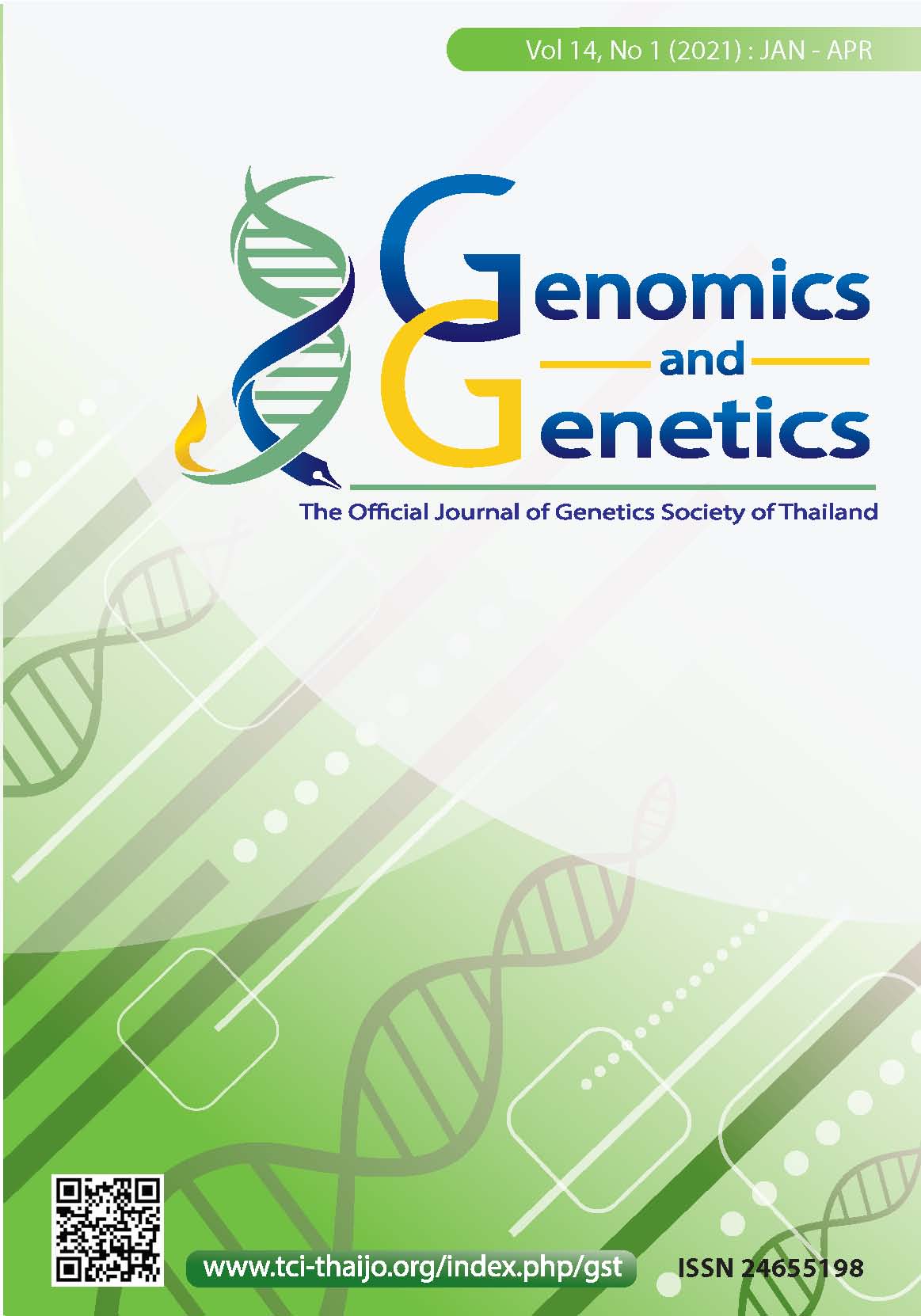DNA profiling of microdissected spermatozoa
DOI:
https://doi.org/10.14456/gag.2021.2Keywords:
DNA profile; laser microdissection; spermatozoa; sexual assaultAbstract
In sexual assault cases, DNA profiling for perpetrator identification requires isolation of pure spermatozoa because evidences are often mixture between the sperm cells and the victim’s cells. Laser microdissection is a powerful tool that directly separates and collects the sperm cells without contamination from another cell. The objectives of this report are to study DNA profiling of laser microdissected spermatozoa for personal identification and to study different factors that may affect the interpretation of DNA profiles from laser microdissected spermatozoa. First, we demonstrated the ability of laser microdissection to identify and genotype spermatozoa. Second, three stains; H&E, eosin and sperm HY-LITER® were evaluated on quality of DNA profiles that derived from laser microdissected spermatozoa. Finally, STR analysis was performed on laser microdissected cell from stained slides that stored in various time. The results showed that at least 150 sperm cells were required to obtain a complete DNA profile, whereas, a partial DNA profile was obtained from 25-75 haploid sperm cells. In staining comparison result, Hematoxylin & Eosin provided the best result of DNA profiles and suitable to apply for laser microdissection. In addition, we obtained complete DNA profiles from stained slide stored for 1 month whereas the stained slide stored for 12 months gave poor DNA profiles. It showed that stained slide storage time had an effect to DNA quality and DNA analysis. In conclusion, laser microdissection is a useful tool to isolate sperm cells and makes a chance to generate genetic profile from low number of sperm cells. However, number of starting sperm cells, staining and duration of storage time are factors that affect the quality of the DNA profile derived from laser microdissected spermatozoa. In addition, to obtain reliable DNA profiles, it is recommended to avoid the factors that may have negative effect on DNA typing process.
References
Costa S, Lima G, Correia-de-Sa P, Porto MJ, Caine L (2017) Assessment of DNA and mtDNA Degradation in Sperm Cells Collected by Laser Micro-dissection. J Forensic Res 8: 393. doi:10.4172/2157-7145.1000393
Curran S, McKay JA, McLeod HL, Murray GI (2000) Laser capture microscopy. J Clin Pathol: Mol Pathol 53: 64–68.
Di Martino D, Giuffre G, Staiti N, Simone A, Le Donne M, Saravo L (2004) Single sperm cell isolation by laser microdissection. Forensic Sci Int 146 (Suppl): S151-153.
Elliott K, Hill DS, Lambert C, Burroughes TR, Gill P (2003) Use of laser microdissection greatly improves the recovery of DNA from sperm on microscope slides. Forensic Sci Int 137:28-36.
Elliott K, Hill DS, Lambert C, Burroughes TR, Gill P (2004) Use of laser microdissection greatly improves the recovery of DNA from sperm on microscope slides. Int Congr 1261: 45-47.
Emmert-Buck MR, Bonner RF, Smith PD, Chuaqui RF, Zhuang Z, Goldstein SR, Weiss RA, Liotta LA (1996) Laser Capture Microdissection. Science 274: 998-1001.
Espina V, Wulfkuhle JD, Calvert VS, VanMeter A, Zhou W, Coukos G, Geho DH, Petricoin III EF, Liotta LA (2006) Laser-capture microdissection. Nat Protoc 1:586–603.
Gill P, Jeffreys AJ, Werrett DJ (1985) Forensic application of DNA ‘fingerprints’. Nature 318: 577-579.
Gillooly JF, Hein A, Damiani R (2015) Nuclear DNA Content Varies with Cell Size across Human Cell Types. In: Cold Spring Harb Perspect Biol 7: a019091.
Hara M, Nakanishi H, Takahashi S, Kido A, Saito K, Takada A (2013) STR and Y-STR genotyping of 30-50-year-old semen stains. Forensic Sci Int Genet Suppl Series 4: e99-e100.
Li C, Han J, Ren W, Ji A, Xu X, Hu L (2011) DNA Profiling of Spermatozoa by Laser Capture Microdissection and Low Volume-PCR. PLoS ONE 6(8): e22316. doi:10.1371/journal.pone.002231
Lucy D, Curran JM, Pirie AA, Gill P (2007) The probability of achieving full allelic representation for LCN-STR profiling of haploid cells. Sci Justice 47: 168–171.
Martino DD, Giuffre G, Staiti N, Simone A, Donne ML, Saravo L (2004) Single sperm cell isolation by laser microdissection. Forensic Sci Int 146S: S151-S153.
Martino DD, Giuffre G, Staiti N, Simone A, Todaro P, Saravo L (2004) Laser microdissection and DNA typing of cells from single hair follicles. Forensic Sci Int 146S: S155-S157.
Miyazaki T, Hara M, Ichiki A, Yamamoto Y, Takada A, Kido A, Nodera M, Yanagisawa H, Suzuki H, Saito K (2008) An efficient novel method for analyzing STR loci from a single sperm captured by laser microdissection. Forensic Sci Int: Genet Suppl Series 1: 437-438.
Murray GI (2007) An overview of laser microdissection technologies. Acta Histochemica 109: 171-176.
Norris JV, Evander M, Horsman-Hall KM, Nilsson J, Laurell T, Landers JP (2009) Acoustic Differential Extraction for Forensic Analysis of Sexual Assault Evidence. Anal Chem 81: 6089–6095.
Rodriguez JJRB, Calacal GC, Laude RP, De Ungria MC (2019) Integrating presumptive and confirmatory semen tests into DNA profiling of sexual assault evidence: a Philippine example. Egyptian J Forensic Sci 9: 45.
Sanders CT. Sanchez N, Ballantyne J, Peterson BA (2006) Laser microdissection separation of pure spermatozoa from epithelial cells for short tandem repeat analysis. J Forensic Sci 51: 748-757.
Schoell W, Klinstchar M, Mirhashemi R, Pertl B (1999) Separation of sperm and vaginal cells with flow cytometry for DNA typing after sexual assault. Obstet Gynecol 94: 623–627.
Simons JL, Vintiner SK (2011) Effects of Histological Staining on the Analysis of Human DNA from Archived Slides. J Forensic Sci 56: S223-S228.
Wiegand P, Schurenkamp M, SchutteU (1992) DNA extraction from mixtures of body fluid using mild preferential lysis. Int J Leg Med 104: 359–360.
Downloads
Published
Issue
Section
License
Copyright (c) 2021 Genomics and Genetics

This work is licensed under a Creative Commons Attribution-NonCommercial-NoDerivatives 4.0 International License.



